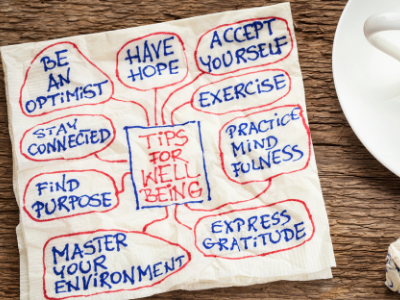In the pursuit of good health, we often mix up what is most important and what it all means.
We often hear people talk about improving their health. Our first thought in creating good health is often weight loss, focusing solely on diet and exercise. We do the obligatory “I will start on Monday” routine. We say that we won’t eat any more “bad” foods and we will exercise every day. We’ll cut out everything that we deem unhealthy and go all in. This very thought process usually means you eat low calorie, cut out or restrict much-needed macro-nutrients (which usually ends up being carbs), exercise excessively, force yourself to NOT eat foods you love, and do all of it all at once.
The problem is that diet culture has us believing that it’s all about our diet or being on a diet and how much we exercise. This means that our focus is solely on weight loss as the pillar of good health, leaving out so many important components of wellness and making sustaining good health nearly impossible.
It is forecast that the health and wellness industry (let’s face it, this is the diet industrial complex) will reach sales of over $20 million USD in 2022 ($25.5 million CAD). This may not seem all that alarming to you, but the truth is that most of this is just repeat business. These statistics reflect the sale of diet products, diet foods, supplements, and diet programs, which people buy over and over again hoping they will get it right this time.
Despite all of that money being spent to create better health, about three-quarters of Canadians are not getting enough physical activity, and more than half of Canadians are not eating as healthily as they should. This varies and is unique to you, but generally, we should focus on more variety and food rotation for the vitamins and minerals our bodies need. Getting more fibre, low-sugar fruits, and vegetables is important as well.
Clearly, the astronomical amount of money that the diet industry is making is frankly becoming part of the problem rather than the solution. This industry has been making millions off of our lack of knowledge, our fear, and our need for instant gratification, all in the name of our current societal standards, which happen to be unrealistic and extremely hard to maintain. Our appearance has been used as an indicator of our health, further underlining these unrealistic beauty and body standards.
There is a better way forward. If we focus more on how we FEEL over how we LOOK, the process of creating good health is much more rewarding and sustainable, though we must realize that creating change is never easy.
What we do not hear people talking about is their wellness. There is a difference between your wellness, which you actively pursue and practice daily, and your health, which is the outcome of what you do daily. Wellness, by definition, is a state of being. Health is a state of body. Good health, which means you are free from illness and injury, is your endgame, your ultimate goal. Wellness is created by the healthy habits you adopt and incorporate daily; these healthy habits are your objectives that get you to the ultimate goal of good health. In order for us to be in good health we need to practice wellness daily. In order for us to practice wellness daily, we need to adopt new healthier habits, in terms of more than just diet and exercise.
There are seven components to wellness: physical, emotional, spiritual, social, environmental, occupational, and intellectual. As you can see, this is far beyond simply diet and exercise.
The process of habit change is one of self-investigation, discovery of strengths, weaknesses, and behavioral discrepancies, which can be uncomfortable and leave us feeling exposed (and may have been why we stuck to diets and over-exercising previously). Changing your habits has nothing to do with the cookies you eat or the type of workout you do: it is why, how much and when you eat or exercise the way that you do that matters more.
Practicing wellness daily should be solution-based. Once you know what your strengths are, use those to create healthy habits instead of worrying about what you think is wrong with you, because the reality is that there is nothing wrong with you. You have been blessed with uniqueness and strengths; you just have to find them.
Humans are supposed to be intuitive and adaptive. Our bodies send us messages all day, every day, we just don’t always listen. We have to learn to adapt, and become more mindful of what our bodies are telling us. Keep your eyes open for a future article about mindfulness, as it needs to be considered in some detail!
The first step to helping you practice wellness daily and using all seven components is goal setting. Weight loss, fitting into your jeans, and looking good are not goals — they are subjective outcomes, which also means that restrictive diets and excessive exercise are not the solution. (Yes, you do need to eat healthily and you need to move, but in a way that nourishes you, not drains you.) Only 5% of people trying to create “good health” actually reach their goals and keep them for over a year. This is because they focus on the number on the scale and what they see in the mirror. When you look in the mirror and see something you don’t like, start looking yourself in the eyes instead. Your goals should be the habits that you want to adopt. These are the action steps that you take towards creating wellness in your life on a daily basis. Your goals should be progressive so that they don’t become overwhelming (which makes you want to stop and go back to your old habits). Your mind will push you in the wrong direction or tell you that you aren’t worthy if you overwhelm it or try to do something you’re not ready to do.
Know your big picture (your long-term goal of good health), but just like athletes do, use daily mental rehearsals to keep you engaged in the journey, not just the destination. Instead of just loving what the big picture looks like and feels like, imagine the steps you need to take, including the potential obstacles and struggles. Then think of how great it will feel to tackle and maintain new habits. The power these accomplishments hold is what keeps you moving forward.
When looking at habits you want to adopt, think of the seven components. Write a list with two habits relating to each component, then break it down again from there. Keep breaking it down until you see things that you know you can do right now. Choose a couple and start doing them.
Each week, add another step, but only when you master the previous step(s). If you are struggling to master one (or some), then break it down more. Every time you master a new habit, it creates motivation for the next objective; which is why it’s important to tackle one thing at a time. Multitasking is overrated.
Wellness is a beautiful thing to work on, because even in moments where you may not be able to eat exactly how you think you should be or can’t workout, there are so many things you can do. If you can’t support your body one day in a particular way, show up for yourself in another way. This could be going for a walk, being mindful of portion sizes, meditating, taking a needed break, taking on a new hobby, listening to an educational podcast, spending time with your family, etc.: just show up for yourself in some way every day. The key is to recognize these small things as contributing to your wellness; don’t take these things for granted. Embrace it as such and do so every day. If you do something because you feel you must, it becomes work, not wellness.
Wellness isn’t linear. There will be good days and off days. It won’t be perfect and shouldn’t be. We learn from obstacles and struggles — or at least we should be! The whole “I will start on Monday” thing comes from thinking that wellness should be restrictive and perfect.
Wellness means that you are happy, full of energy, confident, and have created self-awareness and self-actualization. This doesn’t mean you will feel it every day, but it does mean you will feel it most days in some way. Challenge is key to growth but we often overstep and take on things that create more conflict. Challenge should not be torturous or demeaning. Challenge yourself, but in a way that is still kind.
Don’t be so hard on yourself. We are all doing the best we can. You don’t have to take it all on and rush to the finish line. The best part of all of this is the journey to the big picture. Your body is not a problem to be solved; work on healing that relationship to your body. Treat yourself like you treat the ones you love — you deserve that, too. This is the first step to creating wellness. Realize that your body deserves to be nurtured, it deserves patience, love, kindness, and the right kind of challenge.
Remember that wellness is a daily practice that involves all seven components. Just show up every day doing something good for each of them, even if it can only be in a small way. Consistency is key. You don’t need perfection, you need progress. The practice of wellness is a mindset first and foremost, one that allows you to be okay with being perfectly imperfect. Wellness and life are meant to be harmonic. Balance is unachievable, because it means everything gets equal play and we all know that is impossible. Harmony is key. Sometimes one thing will be more important than other things and this will change weekly or daily — this includes your wellness. Roll with it in blissful harmony and watch how you create good health and keep it!
Source
Government of Canada. n.d. Health and Wellness Trends in Canada. Url: https://www.agr.gc.ca/eng/customized-report-service-health-and-wellness-trends-in-canada/?id=1554401656839 (accessed Feb. 6, 2021).




